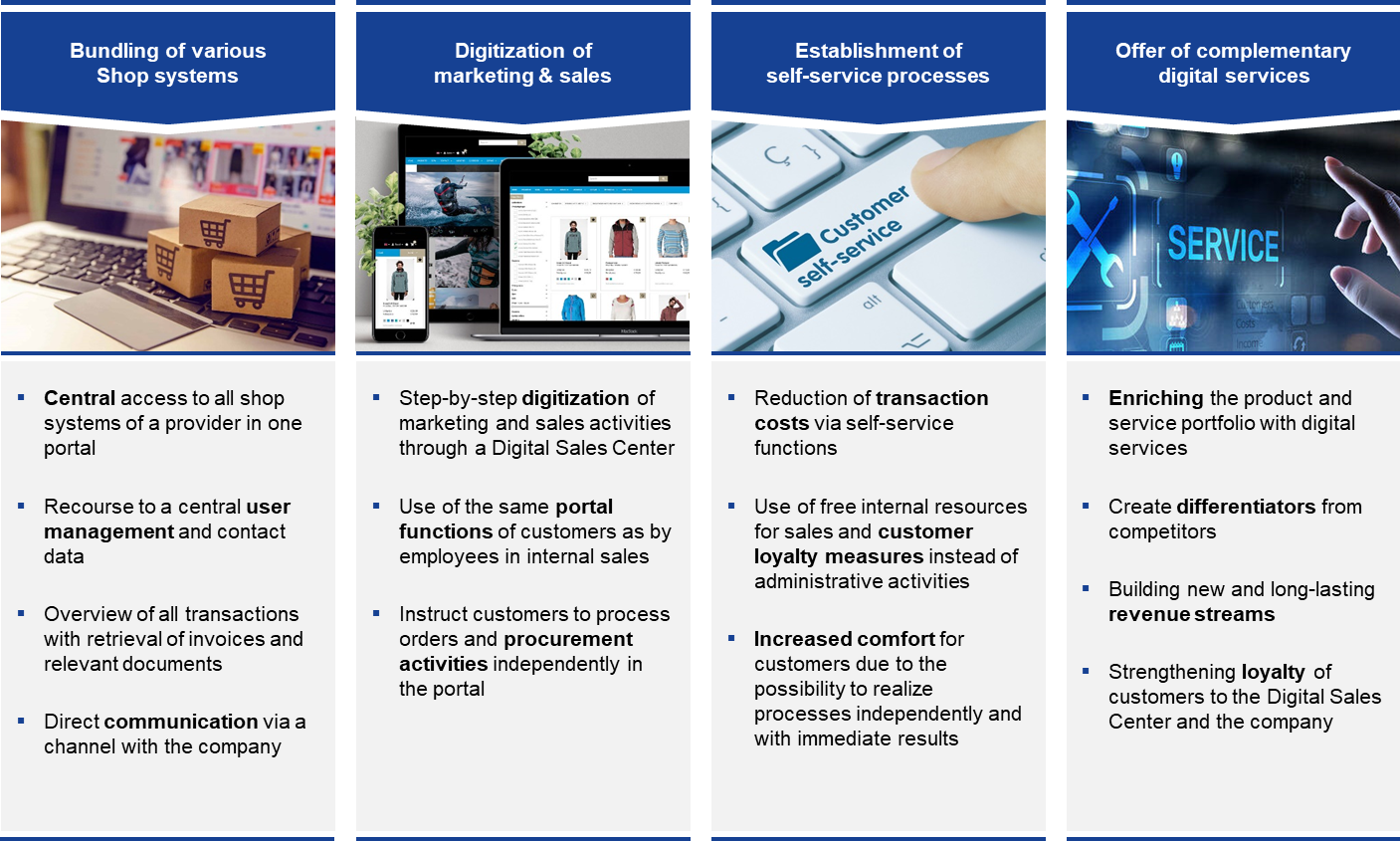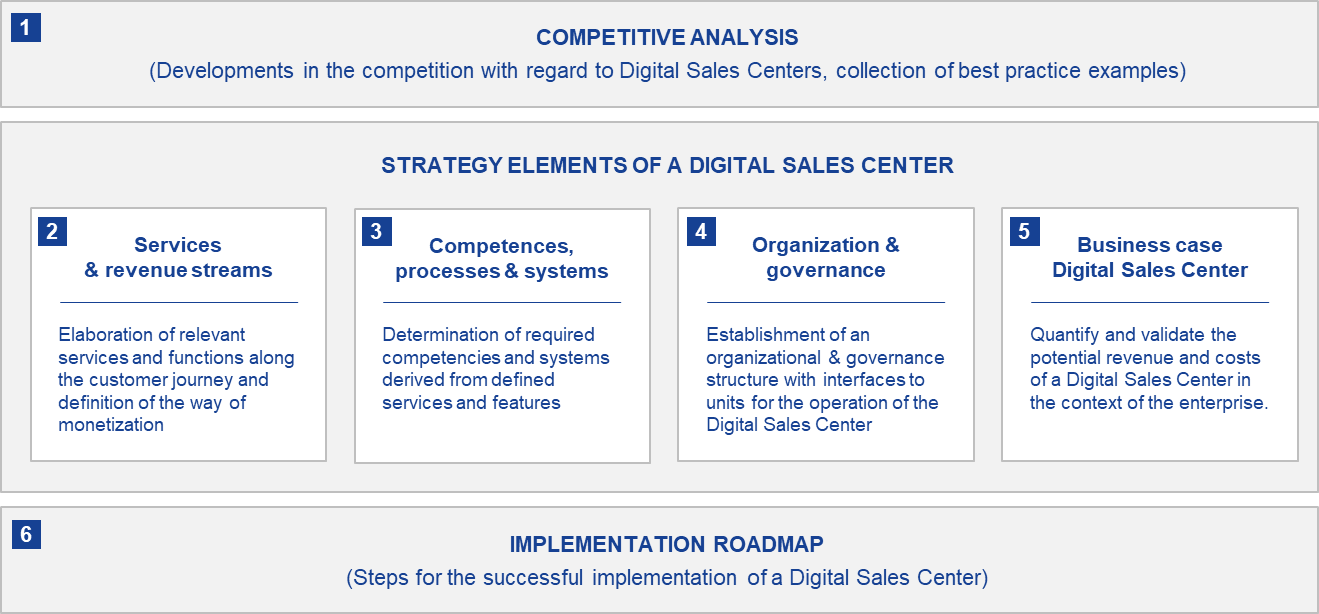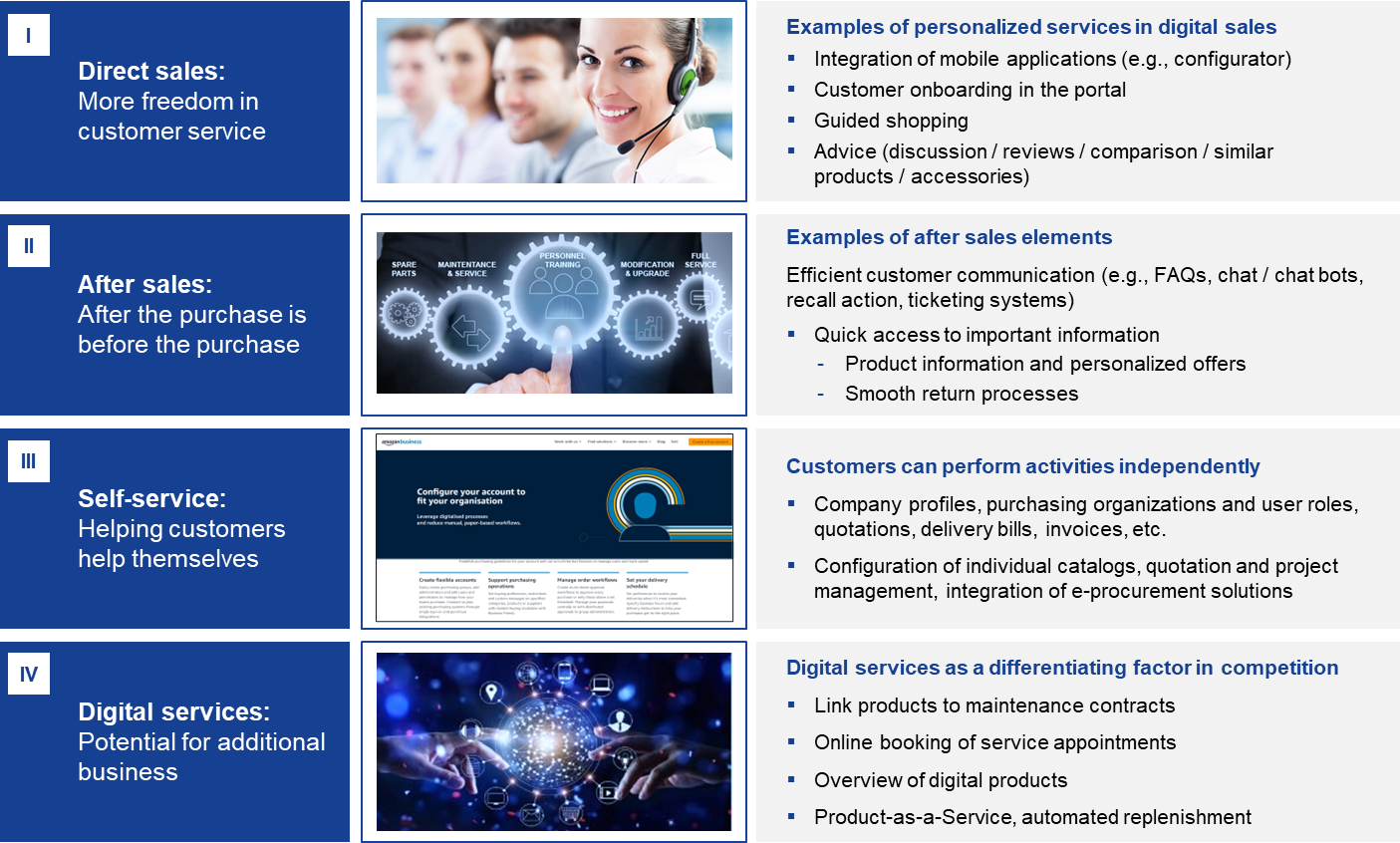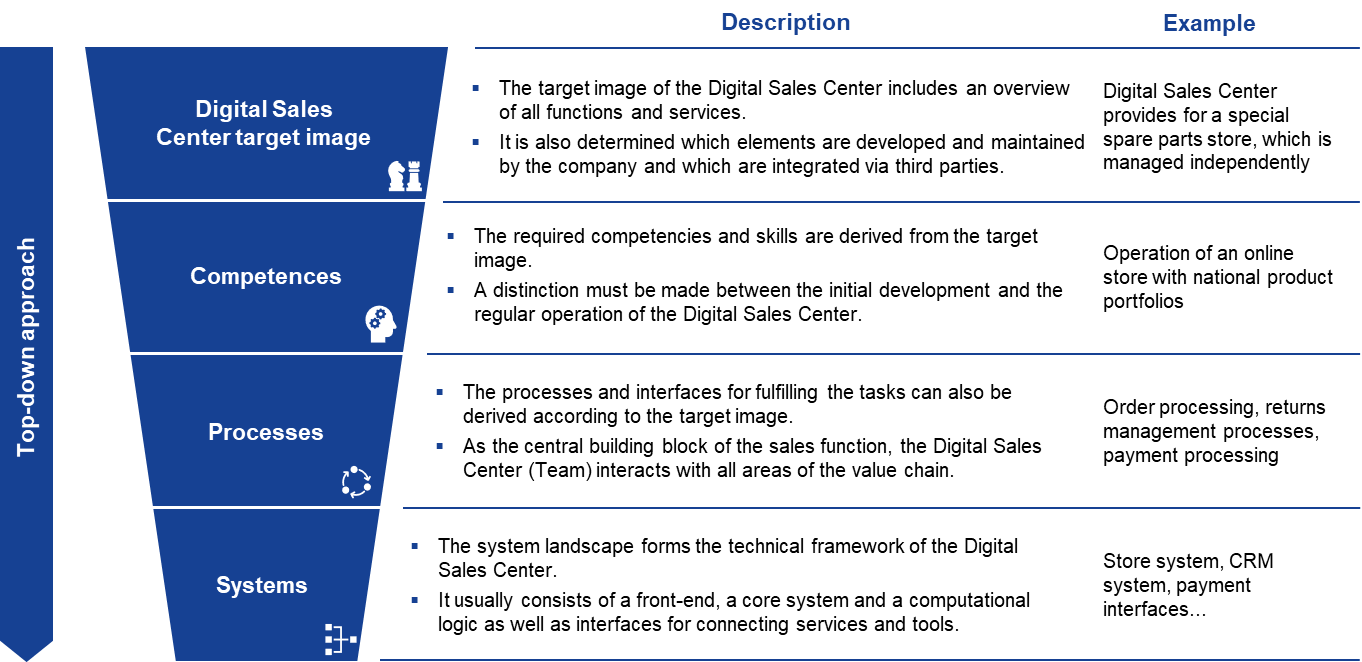
Concept & application areas of a Digital Sales Center
The expectations of customers and consumers are constantly rising – in both the B2C and B2B segments. Products are becoming smarter, offering additional digital functions, and the variety and range of services is increasing, giving consumers greater flexibility – whether in the form of a car subscription, short-term rental of scooters and bicycles, or home delivery of supermarket orders in the shortest possible time. In addition to the demands placed on products and services, the focus is also on the digital shopping experience itself.
A Digital Sales Center addresses this challenge of creating a shopping experience-oriented portal solution from a customer-centric perspective. The goal is to bundle store systems and shopping options for customers on a single platform with a single point of access. Marketing and sales activities are to be carried out digitally in the customer interaction and customers are to be offered extensive and supportive self-service processes to reduce transaction costs and increase the convenience of shopping. The product and service portfolio is to be enriched with the help of additional digital services. In this way, companies can differentiate themselves from the competition and create additional sources of revenue.

Figure 1: Necessity of a Digital Sales Center (DSC)
A Digital Sales Center is a digital sales portal that gives customers access to a comprehensive range of services in addition to the actual product purchase with a single login. It offers services and functions along the entire customer journey, increases loyalty and engagement with the customer, and establishes new revenue streams from digital services for the company. The four core elements of a Digital Sales Center include direct sales, after sales, self-service, and digital services.
Added value and characteristics of a digital sales center
A Digital Sales Center is geared to the requirements of the customer in order to create a convenient digital shopping experience while at the same time increasing the efficiency of sales. Personalization is of particular importance in the context of customer centricity. A Digital Sales Center enables the personalization of views for an easier and more individual user experience, while also simplifying the personalization of products. Cross-selling and upselling options are easier to offer via a central portal and lead to more sales potential. Customer retention and loyalty are promoted through a continuous exchange of information, direct contact persons and an individualized offer. For both the company and (potential) customers, there are numerous added values overall.
- Bundling of information & services: A digital sales center bundles services and information along the customer journey and makes it easier for (potential) customers to search via a single channel.
- Lead generation light: The portal attracts potential customers through the advisory functions and thus acts as a lead generation tool.
Customer analysis: Actions of Digital Sales Center users can be analyzed to derive optimizations for the portal as well as the development of further services. - Personalization & sales increase: The Digital Sales Center simplifies the personalization of offers and opens up numerous opportunities for cross-selling and up-selling.
- Harmonized corporate identity: Consistent design throughout the company’s online presence and creation of uniform touchpoints – thus stronger identification with the brand.
- Convenience & individualization: Bundled access to information and services improves the shopping experience and can be further enhanced by individual views.
- Sales efficiency: Digital sales centers reduce and channel inquiries from customers, making sales more efficient and allowing them to invest more resources in consulting and sales.
- Satisfaction & time management: Customers can independently perform activities in the portal using self-service processes according to their free time allocation, which increases the satisfaction level.
Strategic approach for a Digital Sales Center
Six strategy elements are recommended for the design and implementation of a digital sales center. The starting point for strategy development is an analysis of the competition to determine their maturity and best practice examples. The actual concept is developed in four further strategy elements. Content, technical infrastructure and personnel resources are defined here and potential revenues and costs are validated in a business case before an implementation roadmap can be drawn up.

Figure 2: Strategic approach for a Digital Sales Center
A. Competitive analysis
The primary objective of the competitive analysis is to gain an understanding of the maturity of competitors with regard to digital sales portals. In addition to the question of whether competitors offer a digital sales portal at all, inspiration should also be gained as to which features and functions are currently offered. Best practice examples should provide information on what has been established and proven by others and what should rather be avoided. At the end of the competition phase, a ranking of the maturity of the own company and the predefined peer group is available.
B. Strategy elements of a Digital Sales Center
The central challenge for the target image of a digital sales center is the functions and services to be offered. The first phase therefore deals intensively with defining these and prioritizing them during development and integration.
A digital sales center combines four core elements: Digital Sales, After Sales, Self-Service and Digital Service. Digital Sales describes all features related to the direct sale of products and services. Product consultation tools, configurators, and also the integration of third-party providers in the company’s own online store fall under this heading. After sales comprises services that are relevant after the purchase has been completed. These include efficient communication channels for customers to get help as quickly as possible in the event of problems with the product. But also fast and efficient inspection and warranty contracts, manuals and ordering options for spare parts. Self-service functions are designed to enable customers to initiate processes independently – from changing master data to managing contracts. Digital services form a pool for all digital tools and solutions that can be used individually or in combination with a product. Predictive maintenance tools and digital training options are found here, particularly in the technical context.

Figure 3: Core elements of a Digital Sales Center
Once the target image of the Digital Sales Center with services and functions has been defined, the necessary competencies, processes, and systems are derived using a top-down approach. Competencies do not necessarily have to be available within the company, but can also be brought in from outside – especially in order to obtain special expertise.

Figure 4: Competencies, processes and systems
The organization and a governance structure will be built up step by step and will initially focus on developing the core system of the Digital Sales Center, the front end, and the initial digital services in order to create added value for customers. Over time, the focus is on the expansion of services, whereby these can also be incorporated into the system by integrating third-party providers and partnerships. The final element of the concept is the quantification and validation of potential revenues and costs with a business plan.
C. Implementation Roadmap
An implementation roadmap defines the steps required to successfully implement the target image of the Digital Sales Center. A future-proof and adaptable digital sales center IT architecture is required. Detailed IT specifications must be compiled and used for invitations to tender with IT service providers. Compatibility with existing and planned systems and tools must be taken into account when selecting digital sales center technology. Parallel to the selection of IT systems, the organization and governance project is initiated and the organization is built up according to maturity phases. An experienced Project Management Office (PMO) should be set up for the entire implementation project.
Prerequisites and success factors
Customer-centricity as a new mindset in the company is the new motto for successful integration and application of a Digital Sales Center. The following success factors have emerged from the experience of numerous projects for the development of portal solutions and digital sales centers:
- Services & functions with added value: Services and features in the company must create added value for (potential) customers. Caution is advised with an unstructured collection that causes more complexity than a pleasant digital shopping experience.
- System openness for partners: The digital sales center structure should be designed in such a way that services from partners can be easily integrated. Not all components can be provided by the company itself in terms of resources.
- Open exchange within the company: The establishment of a digital sales center affects all departments of the company. Involvement and an open exchange are therefore important for establishing customer centricity in the company and creating acceptance.
- Speed of implementation: Once the measures have been decided, they must be implemented as quickly as possible. In this way, feedback can be incorporated quickly and the Digital Sales Center optimized.
- Expertise in the project team: The project team must be equipped with the necessary competencies and powers to be able to act. This relates to personnel, technical and conceptual decisions in the Digital Sales Center implementation.
- Clear areas of responsibility: When assigning tasks, it is important that team members are given clearly defined and delineated areas of responsibility in order to implement the measures in the best possible way.
- Prioritization: A digital sales center comprises many components. It is important that these are prioritized uniformly in order to approach the integration and development effort step by step. The same applies to the integration of third-party functions.
- Customer-centricity mindset: Establishing a digital sales center requires a change in thinking and a focus on more customer-centricity within the company. B2B-influenced companies in particular must undergo this mindset shift.
Your contact for questions on the Digital Sales Center

Markus Fost, MBA, is an expert in e-commerce, online business models and digital transformation, with broad experience in the fields of strategy, organisation, corporate finance and operational restructuring.
Learn moreMarkus Fost
Download the service overview for our Digital Sales offering as an overview.
Please provide your name and e-mail address to receive an e-mail with the according PDF file free of charge.




